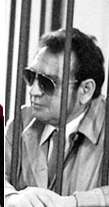Luigi Vollaro

Luigi Vollaro (San Sebastiano, province of Naples, December 18, 1932 - Milan December, 3, 2015)[1] is a member of the Camorra and boss of his name-sake, the Vollaro clan from Portici and San Sebastiano a Vesuvio, a small village in the Vesuvius area, east of Naples.
He founded the Vollaro clan during the mid-seventies. During his tenure as a Camorra boss, Vollaro earned the nickname "'o Califfo" (The Caliph) for his alleged unlimited sexual potency. When he eventually was arrested in 1982, the police found that Vollaro was living in a concubinage with 17 women and had 27 children. When asked by the judge whether he belonged to the Camorra, he replied: "What is the Camorra? A criminal organization, they say. I belong only to my family. I mate only with my women."[2]
In 1982, Luigi Vollaro was arrested after spending three years on the run and was charged with the murder of Giuseppe Mutillo in 1980. Vollaro was later sentenced to life imprisonment for this murder. In 2003, Vollaro received a second life sentence for the murder of Carlo Lardone in 1977.[3]
In 1992, Vollaro was subjected to the harsh Article 41-bis prison regime, thus having the distinction of being one of the first Camorra bosses to be subjected to this regime. For a short period after his arrest, the management of his illegal businesses went to his sons Pietro, Giuseppe and Raffaele. Another son, Antonio who had dissociated from the family business early on, was wrongly detained years for a murder committed by his brother Ciro. Ciro admitted to the murder after becoming a pentito (collaborator with Italian Justice) and with his confessions, dealt a massive blow to the clan's activities.[1]
References
- 1 2 (Italian) La Storia della famiglia Vollaro di Portici, Cronache Di Camorra blogspot, July 7, 2008
- ↑ Jacquemet, Credibility in Court, p. 48
- ↑ (Italian) L'ergastolo per il boss Luigi Vollaro, La Repubblica, June 4, 2003
- Jacquemet, Marco (1996). Credibility in Court: Communicative Practices in the Camorra Trials, Cambridge University Press ISBN 0-521-55251-6